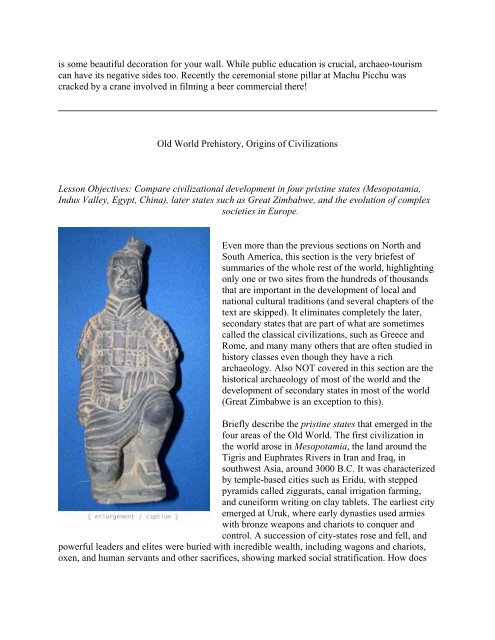INTRODUCTION TO ARCHAEOLOGY Nancy White - Touro Institute
INTRODUCTION TO ARCHAEOLOGY Nancy White - Touro Institute
INTRODUCTION TO ARCHAEOLOGY Nancy White - Touro Institute
You also want an ePaper? Increase the reach of your titles
YUMPU automatically turns print PDFs into web optimized ePapers that Google loves.
is some beautiful decoration for your wall. While public education is crucial, archaeo-tourism<br />
can have its negative sides too. Recently the ceremonial stone pillar at Machu Picchu was<br />
cracked by a crane involved in filming a beer commercial there!<br />
Old World Prehistory, Origins of Civilizations<br />
Lesson Objectives: Compare civilizational development in four pristine states (Mesopotamia,<br />
Indus Valley, Egypt, China), later states such as Great Zimbabwe, and the evolution of complex<br />
societies in Europe.<br />
Even more than the previous sections on North and<br />
South America, this section is the very briefest of<br />
summaries of the whole rest of the world, highlighting<br />
only one or two sites from the hundreds of thousands<br />
that are important in the development of local and<br />
national cultural traditions (and several chapters of the<br />
text are skipped). It eliminates completely the later,<br />
secondary states that are part of what are sometimes<br />
called the classical civilizations, such as Greece and<br />
Rome, and many many others that are often studied in<br />
history classes even though they have a rich<br />
archaeology. Also NOT covered in this section are the<br />
historical archaeology of most of the world and the<br />
development of secondary states in most of the world<br />
(Great Zimbabwe is an exception to this).<br />
Briefly describe the pristine states that emerged in the<br />
four areas of the Old World. The first civilization in<br />
the world arose in Mesopotamia, the land around the<br />
Tigris and Euphrates Rivers in Iran and Iraq, in<br />
southwest Asia, around 3000 B.C. It was characterized<br />
by temple-based cities such as Eridu, with stepped<br />
pyramids called ziggurats, canal irrigation farming,<br />
and cuneiform writing on clay tablets. The earliest city<br />
emerged at Uruk, where early dynasties used armies<br />
with bronze weapons and chariots to conquer and<br />
control. A succession of city-states rose and fell, and<br />
powerful leaders and elites were buried with incredible wealth, including wagons and chariots,<br />
oxen, and human servants and other sacrif ices, showing marked social stratification. How does
















